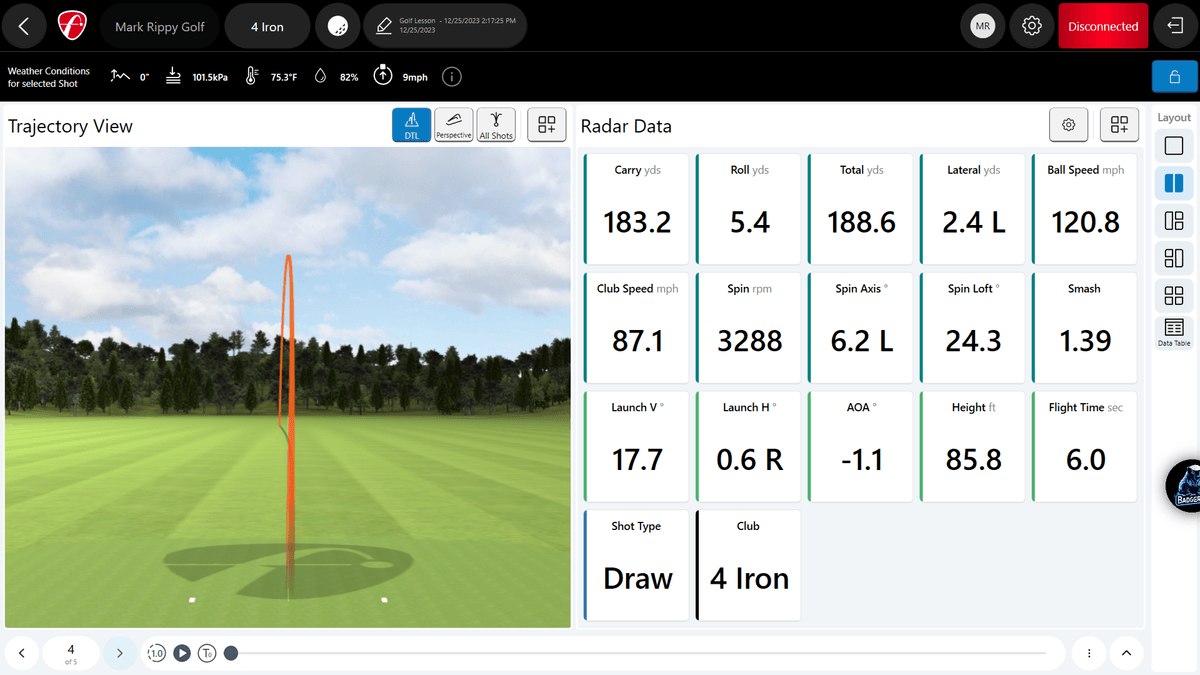When golfers hear about radar numbers, three of the most important—and most connected—are clubhead speed, ball speed, and smash factor. These metrics tell us not just how fast you’re swinging, but how efficiently you’re transferring that speed into the golf ball.
Clubhead Speed
This is the speed of the clubhead at the moment it strikes the ball. It represents your power potential—the faster you swing, the more energy is available.
But clubhead speed alone doesn’t guarantee distance. Two golfers with identical swing speeds may produce very different results depending on how well they strike the ball. The biggest misconception golfers have about clubhead speed is that the more of it you have, the further the ball goes. This however is not true.
I use FlightScope Mevo+ in my lessons because it's reads clubhead speed, and other metrics, directly. But it's not as straight foward as one might think. When the club is delivered to the golf ball at impact, the toe is traveling 7 mph faster than the heel. In ordert to get your clubhead speed, the radar reads the speed of the heel and toe. The two are averaged together to determine the clubhead speed at the center of the face. Thats the number displayed back to you.
Ball Speed
Ball speed is the speed of the golf ball as it leaves the clubface. It’s determined by both clubhead speed and the quality of contact.
- Solid, center-face strikes maximize ball speed.
- Off-center contact (heel, toe, thin, or high/low on the face) reduces ball speed, even if clubhead speed is high.
This is where efficiency comes into play. It's also one of the primary driving factors behind why club makers are racing to make the most forgiving ever.
Smash Factor: The Efficiency Number
Smash factor measures how efficiently energy transfers from the clubhead into the ball. It's derived by dividing ball speed by your clubhead speed. As of this post, the maximum smash factor allowed by the USGA is 1.5. That means that the golf ball can only launch 1.5 times faster than clubhead speed.
For example:
- 100 mph clubhead speed with 150 mph ball speed = 1.50 smash factor.
- 100 mph clubhead speed with 140 mph ball speed = 1.40 smash factor.
The second golfer swings just as fast but loses 10 mph of ball speed due to strike quality or inefficiency. This is the reason why more clubhead speed doesn't always result in more distance. Now that you have any idea of what these numbers mean, review this data from a 4 iron from a practice session of mine.

Why Smash Factor Matters More Than Max Speed
Most amateurs believe hitting the ball farther means simply swinging harder. But in reality:
- A centered strike with 100 mph speed can outperform a faster swing with off-center contact.
- Swing efficiency and timing to get a good strike are far more important than chasing raw speed.
- Tour players don’t just swing fast—they consistently find the middle of the face.
This is why the best golfers in the world spend countless hours perfecting strike location and sequencing instead of trying to add 5–10 mph of speed at the expense of control. What should your smash factor for each club be? Thanks to the "Iron Byron" we are able to develop good guidelines. Here are the typical smash factors by club based on robotic testing.
Typical Smash Factor Benchmarks
Driver: 1.50
3 Iron: 1.46
4 Iron: 1.43 (How does this compare with the shot above?)
5 Iron: 1.43
6 Iron: 1.40
7 Iron: 1.38
8 Iron: 1.36
9 Iron: 1.32
PW: 1.28
LW: 1.05
Notice how smash factor increases as loft decreases. What would we expect to see over time with newer club designs having stronger lofts? Occasionally, you may see a smash factor with your driver at 1.51. You might wonder how this might be possible if 1.5 is the maximum. It's not a misread. This happens from time to time with toe shots. Remember, the toe is traveling faster than the heel as well as the center of the clubface.
Key Takeaway
Clubhead speed, ball speed, and smash factor are inseparably linked. Swinging harder may raise clubhead speed, but unless you can consistently strike the center of the face, you won’t maximize ball speed—or distance.
Improving strike quality and swing efficiency should always come before chasing max speed.
Want to keep learning? Subscribe to my blog and get each new post in this radar number series delivered straight to your inbox!
